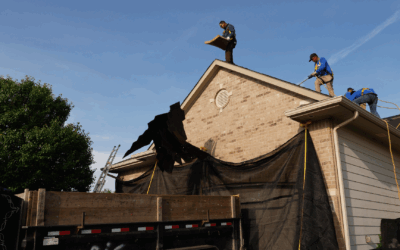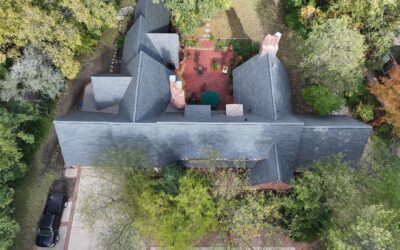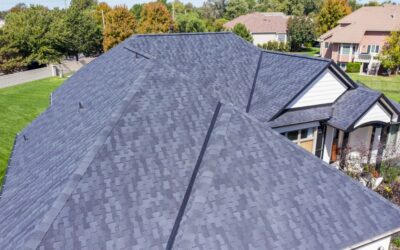Snow guards can be a necessary addition to a roof when snow and ice accumulation present a danger to the occupants. Snow guards prevents snow from accumulating in large sheets and falling to the ground, known as slabbing.
Here in Kansas, snow guards are not generally needed on most homes, with a few exceptions that we’ll cover in this article. In Kansas, snow guards are primarily used on sloped commercial roofs to prevent damage and personal injury to those on the ground, such as around an entrance or near parking spaces.
Here we will discuss what snow guards are, what they do, and why they are sometimes needed. We will also offer a few tips for determining if your roof may need snow guards.
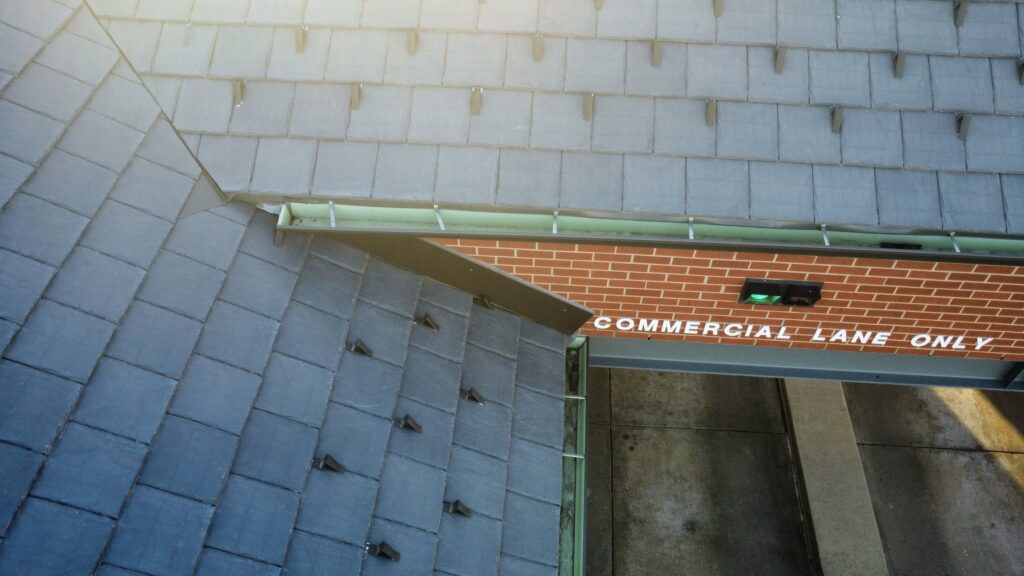
Snow guards used on a commercial tile roof to protect vehicles driving underneath.
What Are Snow Guards and What Do They Do?
A snow guard is a physical barrier installed on a roof that functions as a stop for sliding snow from a roof. They’re like wheel stops for snow. Most snow guards extend vertically beyond the plane of the roof and are used on metal roofing panels, synthetic slate, and some shingle roof systems.
When snow is cohesive, in wet or compacted layers, it behaves like a single, bonded sheet. Once one section begins to move, it can pull any neighboring sections with it. It functions like peeling a sticker: initially, the sticker clings firmly to the surface, but once the edge lifts, the rest can come off in a smooth, unified motion. Cohesive snow behaves the same way: it remains still until the moment a portion releases, then sheds all at once.
This is the same behavior that motivates avalanches. Known as slab propagation, cohesion of snow allows a fracture to extend throughout the snowpack, resulting in large, sudden releases.
Heavy, fast-moving snow can cause property damage and personal injury to those on the ground. Snow guards keep the snow in small, manageable sections instead of one large slab that can slide off the roof unpredictably, inflicting damage.
If the roof also has a steep pitch, this falling slab of snow will gain speed as it slides from the roof. As a result, some building codes require snow guards on exceptionally steep roofs because the roof itself provides little resistance to the sliding snow.
When Do Roofs in Kansas Need Snow Guards?
Most residential homes in Kansas do not require snow guards because we rarely get wet, heavy snow that lasts more than a day or two, but Kansas weather is predictably unpredictable. Roofs can last for decades, so anticipating major shifts in our average weather could prove handy in the future, especially if that shift involves major snowfall.
Snow guards can be added during a roof replacement to mitigate any chance for dangerous slabbing to occur. Although the return on investment for snow guards is relatively low – they don’t meaningfully appreciate home value or reduce insurance premiums like some roof modifications – the peace of mind they provide makes them worthwhile for some homeowners.
While snow guards usually aren’t necessary on most residential properties, there are exceptions.

Metal Roofs
The purpose of snow guards is to slow the speed and reduce the size of falling snow slabs from a roof. Metal roofs provide little resistance to sliding snow and ice because the surface is smooth, unlike the rough granules on a standard asphalt shingle roof.
Bar-style snow guards are common on metal roofs because they are also made from metal, which helps them blend visually with the roof. Roofing and snow guard manufacturers note specific applications for their products, so read the use-cases and directions carefully before investing in snow guards.
Exceptionally Steep or Shallow Roof Pitches
The utility of snow guards depends partly on the slope of the roof. Steep and shallow pitches present opposite challenges.
Steep Roofs (7:12 or greater): Snow releases all at once, often in large sheets. Snow guards can break up these slabs, allowing snow to fall in less dangerous quantities. No snow guard system can – or should – completely prevent snow from falling. Steep slope roofs are water shedding, not waterproof. Preventing snow from falling altogether retains water, allowing water infiltration and potentially creating ice dams (for more information on ice dams, check out our article What Causes Ice Dams on Roofs?). Instead, snow guards reduce the risk of damage or injury by controlling how much snow or ice drops from the roof at once.
Shallow Roofs: Snow lingers on the roof because gravity alone isn’t always enough to cause slabs to fall off the roof. Snow accumulates until it 1) melts, or 2) breaks off suddenly and all at once. In these cases, frequent, accelerated shedding isn’t the risk; instead, the risk is large, heavy slabs falling to the ground. Snow guards help delay shedding until the snow melts and staggers the fall of snow.
Cathedral and Vaulted Ceilings
Cathedral and vaulted ceilings can be vulnerable to snow accumulation because their limited attic spaces are less insulated and are likely to be substantially warmer than a standard attic space. These roof designs convert space that would normally be in the attic into high interior ceilings.
These spaces tend to be underinsulated compared to the rest of the roof because the attic is absent. Insulation is used in the attic to allow it to approximate the ambient temperature, but cathedral and vaulted ceilings lack the space. Snow can remain there longer as a result, so snow guards are frequently used over cathedral and vaulted ceilings in regions where heavy snowfall is common. Alternatively, heat transfers from the conditioned space to the roof more quickly without insulation, resulting in melted snow at the roof, causing unmelted snow to slide down.
To learn what type of attic ventilation your cathedral or vaulted ceiling has, read our article covering attic ventilation systems.
Wood Roof to Synthetic (DaVinci) Roof
Synthetic roof materials like synthetic slate and synthetic wood shingles are smooth and allow snow buildup to slide off easily, similar to metal roofs. Synthetic roofs commonly employ snow guards for this reason, but the snow guards take a different form than those used on metal roofs. Smaller-profile guards, like Rocky Mountain Snow Guards, are often integrated directly into the shingle coursing, unlike the exposed mechanical brackets you might find on a metal roof.
Some roof designs use more than one type of material. For example, in some roof designs, a natural or composite main roof may collect runoff from a roof made from synthetic materials or metal.
To mitigate any damage the falling slabs of snow may cause, snow guards are often installed where synthetic shingles or metal roofs transition into rougher, more textured materials like asphalt shingles. The goal is to slow and distribute snow movement.
Tall Structures (3 or More Stories)
Snow falling in large volumes and at high speeds causes the most damage upon impact. Tall structures, buildings with three or more stories, amplify this effect by giving the snow time to accelerate before impacting the ground.
Snow guards are often required by building code on tall structures with pitched roofs around entrances, doorways, benches, or any other area a person might occupy. However, most residential homes are not three stories tall.
What Types of Snow Guards Are Available?
There are three common types of snow guards, each designed for a specific use.
Fence Style Snow Guards
Fence style snow guards resemble a two-rail fence when installed, hence the name. Fence style snow guards usually include two evenly spaced cylinders that allow the water to flow down and away from the snow as it melts while holding the snow blanket in place.
Bar Style Snow Guards
Bar style snow guards are used almost exclusively on metal seam roofs (not to be confused with metal shingles) as they usually extend prominently across the roof, perpendicular to the metal panels. Bar style snow guards are effective, but they can be an eyesore on the wrong roof.
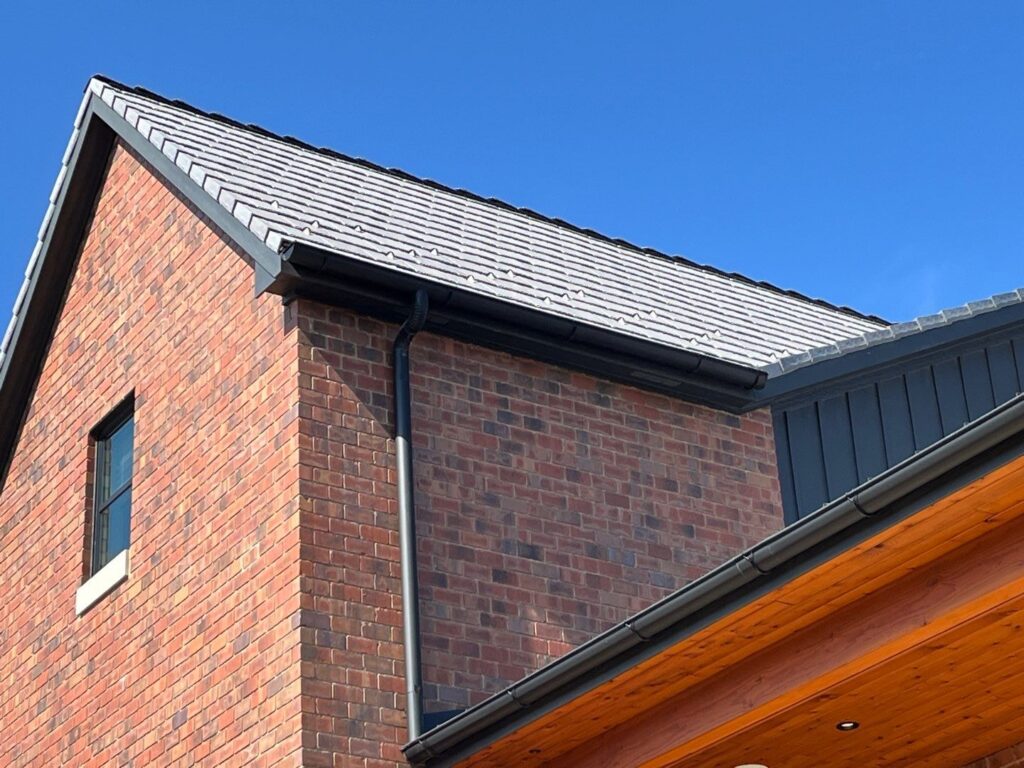
Low-profile discontinuous snow guards as they appear from the ground on a tile roof. Large slabs of snow were falling onto the metal roof below this eave, creating a loud noise and risking damage. These snow guards manage the snow runoff, reducing the noise and protecting the metal roof below.
Large and Small Profile Discontinuous Snow Guards
Both large and small profile snow guards can be installed as part of a new roof, or as a retrofit. Profiled snow guards function as cleats, deflecting the snow as much as they stop it, providing control of the runoff without minimizing it. However, because these snow guards are relatively small, most projects will require a greater number of them compared to fence style or bar style snow guards.
How to Choose the Right Snow Guards for Your Roof
Because snow guards perform a specific purpose, you’ll want to get as much information as possible from an expert. In Kansas, the top roofing company is Rhoden Roofing, located in Wichita.
Rhoden Roofing is certified by several roofing manufacturers to install snow guards when and where they are needed. An expert from Rhoden Roofing will perform a free, no-obligation inspection of your roof and make recommendations for your next steps.
If you would like help deciding if snow guards are for you, click here to schedule an appointment.

